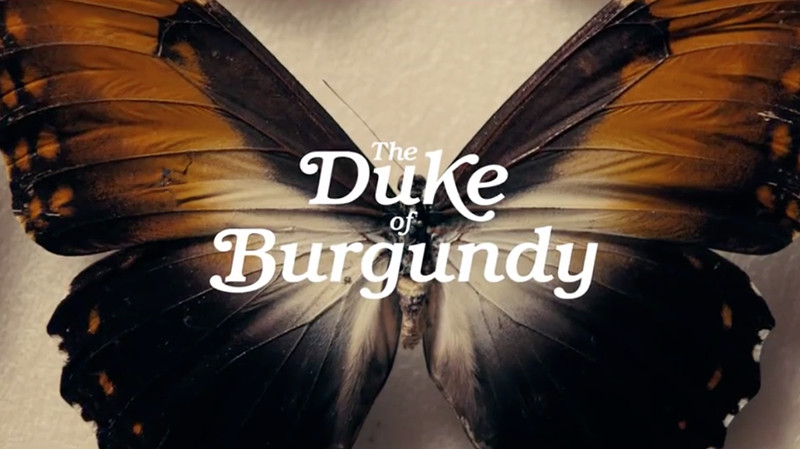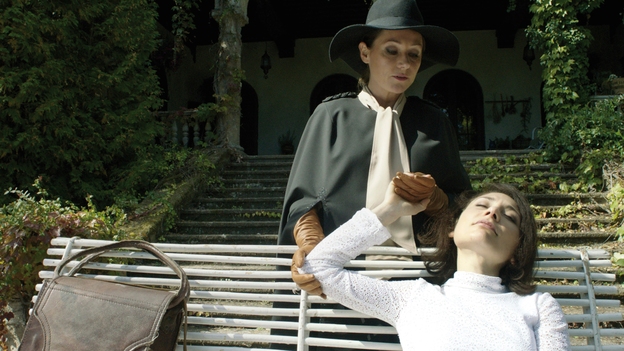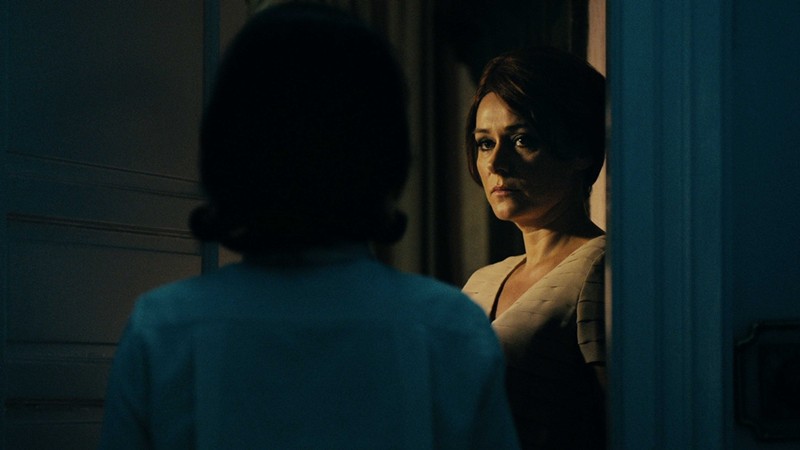
“A complex and ultimately moving on the privileges of victimhood and the nuances of what it means to suffer for love.”
– Stephanie Zacharek, Village Voice
Love’s melody lost
The Duke of Burgundy, which is a reference to the hamearis lucina butterfly found only in Europe, artfully details the love story of two lesbian sadomasochistic entomologists (scientist who studies insects) in the third film from sly English writer-director Peter Strickland.
A consistently curious and distinctively artful erotic drama, The Duke of Burgundy exists in a pocket universe vacant of men, where women dwell as denizens in what appears as a grainy, hedonistic paradise of freeze-frames wet with color, fetes of zooms, fantasies borne with a delicate soap bubble inertia, and dream sequences bound an insectivorous brush and the beating of moth wings.
Here the women reside amidst a seeming sighing torpor and a precise, almost recherché décor that entreats an atmosphere of pseudo-noble post-1960s Eurotrash grindhouse. Strickland doesn’t shy from pastiche as the film readily suggests the psychedelic sex-horror and maudlin melodrama of Jesús Franco (Vampyros Lesbos), Radley Metzger (The Lickerish Quartet), or Jean Rollin (La Vampire Nue), with ideas of intimate domesticity and splashes of the surreal.
“It’s common sense that the masochist calls the shots and that paradox of power is ripe with ideas. I wanted to take the stereotypes from those sexploitation films––female lovers, with the masochist who’s found her savior sadist––and puncture that fantasy.”
– Peter Strickland
Moth in the incubator

Having now made three sensationally singular features, Strickland stands as a distinct and equivocal auteur. His debut from 2009, Katalin Varga, was a strikingly inventive Transylvanian-set revenge thriller, and his follow-up film was 2012’s Berberian Sound Studio, a psychological horror film in giallo dress and a deliberate mindfuck ambition.
With his third and most exacting work, The Duke of Burgundy, it’s now clear that Strickland is operating in the custom of his fellow countrymen of similarly nonconformist lineage as Peter Greenaway (The Cook, the Thief, His Wife & Her Lover), Derek Jarman (Caravaggio), and Ken Russell (The Devils), and like them, is ready to imbue his films with art, drollery, ideas, intelligence, and a shaking provocation.
The seeds for The Duke of Burgundy were sown when Rook Films producer Andy Starke invited Strickland with an opportunity to remake Jess Franco’s sexploitation horror hit Lorna the Exorcist (1974), and while they would ultimately move away from a remake, the director was sold on using Franco as a jumping off point.
It wasn’t until a short time later when Strickland got familiar with Swiss director Cleo Übelmann and her 1986 lesbian art film Mano Destra, when the idea for his third film would really take flight in what the director himself described an an urge to make something “like Chris Marker doing a female-female bondage film.”
And so, in a steamy flash Strickland began to detail the artful and elaborate S&M dynamic which would evolve into the ravishing and roguish fable The Duke of Burgundy.
“The Duke of Burgundy is a beautiful love story disguised as stylish smut… At its core, this is one of the most incisive, penetrating, and empathetic films ever made about what it truly means to love another person, audaciously disguised as salacious midnight-movie fare.”
– Mike D’Angelo, The A.V. Club
The Butterfly Effect

In a haughty, ivy-adorned and moss-covered house nestled somewhere in an inexact European haunt, the romantically variegated relationship between orthopterist Cynthia (Sidse Babett Knudsen)––she studies crickets, grasshoppers, and locusts––and Evelyn (Chiara D’Anna)––who’s studying lepidoptery (the study of moths and butterflies) under her tutelage––whirls around strict role-playing.
At first we see Evelyn, the younger of the two, on her hands and knees, appearing to act out her mistress’s every urgency as a squandered servant. But it’s soon and smartly revealed, as Cynthia yields to her lover’s onerous, degrading and masochistic demands, that the lash is being held in the other velvet gloved hand.
Evelyn is eager to be corrected for her infractions in their idée fixe maid-and-mistress amusement, complete with corseted bondage gear and equipage as well as a moth-named safe word (“pinastri”), and other predetermined procedure and practice––including discreet human toilet play, bondage, and confinement, all displayed more tastefully then listing them off would suggest.
It isn’t long however, before we start to see that Cynthia and Evelyn have their limits and their occasional negligibility, which when unchecked brings the couple close to impassioned falling apart and an inevitable falling out.
“There’s voyeurism, fetishism, bondage, lingerie and high-flown naughtiness galore, but that’s hardly the movie’s most conspicuous achievement. Also at work in this transfixing account of a sado-masochistic relationship on the ropes (so to speak) are a probing intelligence, a catalogue of inspirational cinematic references––and perhaps most impressive––a big, sad, beating heart.”
– Geoff Pevere, Globe and Mail
A moth is not a butterfly

Shot on location in a run-down villa in Hungary––beautifully brought to life in gobsmacking detail by production designer Pater Sparrow––with expert lensing from Strickland’s regular cinematographer Nic Knowland, The Duke of Burgundy is well provided for in its flourishing yet overripe surroundings.
It exists in a decadent and libertine cosmology all its own, and one that feels familiar and yet neoteric, and certainly some of this ethereal air is a direct correlation resulting from the haunting score composed by pop duo Cat’s Eyes (the OST is a must own for audiophiles), which adds immeasurably to Strickland’s hermetic world building.
It would be great folly, perhaps, to categorize this film as pointedly a lesbian movie as nothing about the love and lifestyle of Cynthia and Evelyn is portrayed as anything other than absolute prevalence, but maybe it should be for that very reason? It’s not for me to say but only to consider. But regardless the opinion of a heterosexual male, it’s refreshing to see a love affair of this sort shown not to be in the minority for a change.
Expertly crafted, judiciously arranged, and entirely mesmeric––oh how this film makes me want to, like Evelyn, take my bicycle lurching guardedly through enchanted forests and beyond––The Duke of Burgundy holds many remunerative mysteries. It’s a film with humor, heartbreak and salacious beauty, and one that holds a particular lucidity that is both lush and well-prepared. It’s a film as delicate and strange as the butterfly for which it’s named, and shares a similar shivering grace.
Author Bio: Shane Scott-Travis is a film critic, screenwriter, comic book author/illustrator and cineaste. Currently residing in Vancouver, Canada, Shane can often be found at the cinema, the dog park, or off in a corner someplace, paraphrasing Groucho Marx. Follow Shane on Twitter @ShaneScottravis.